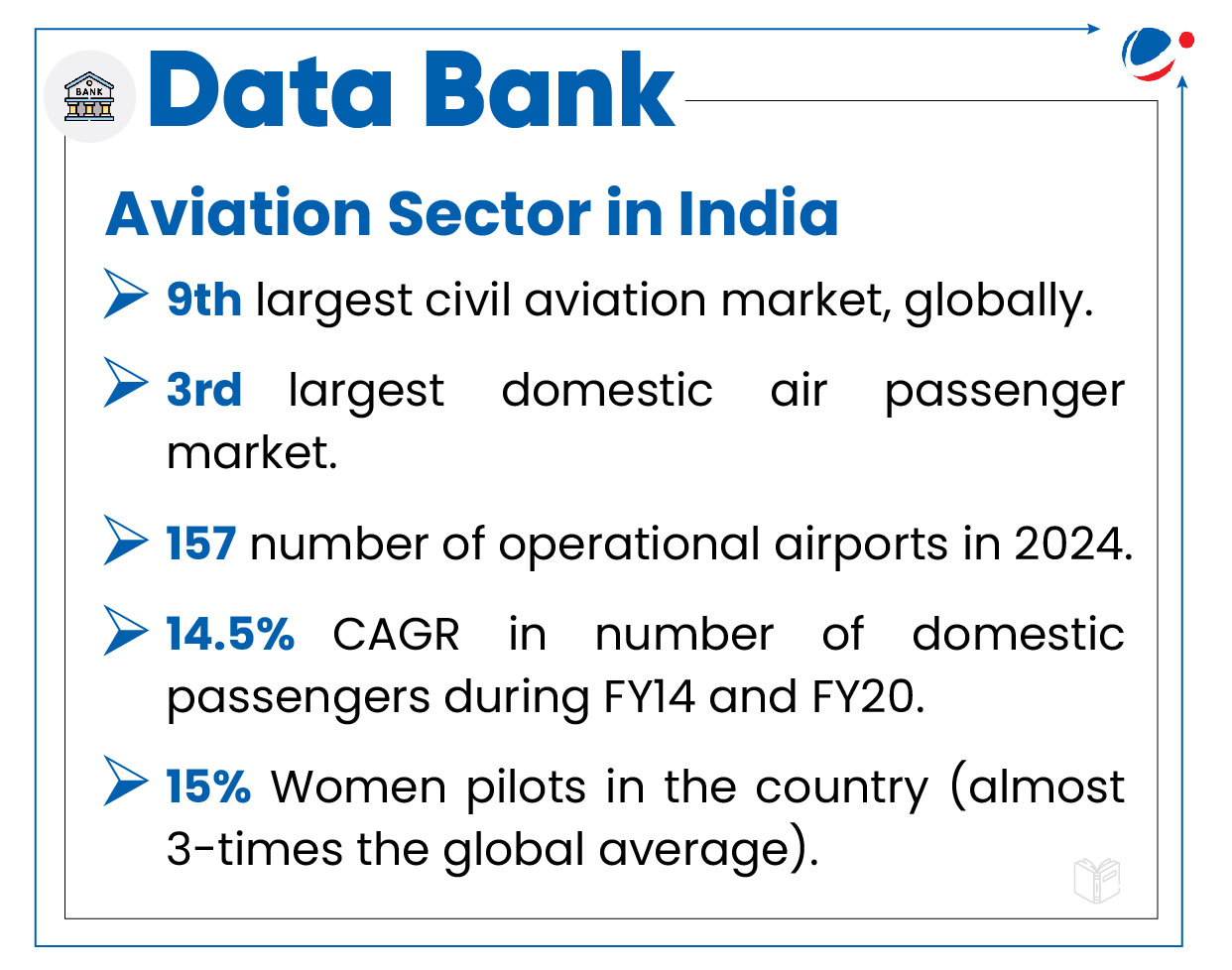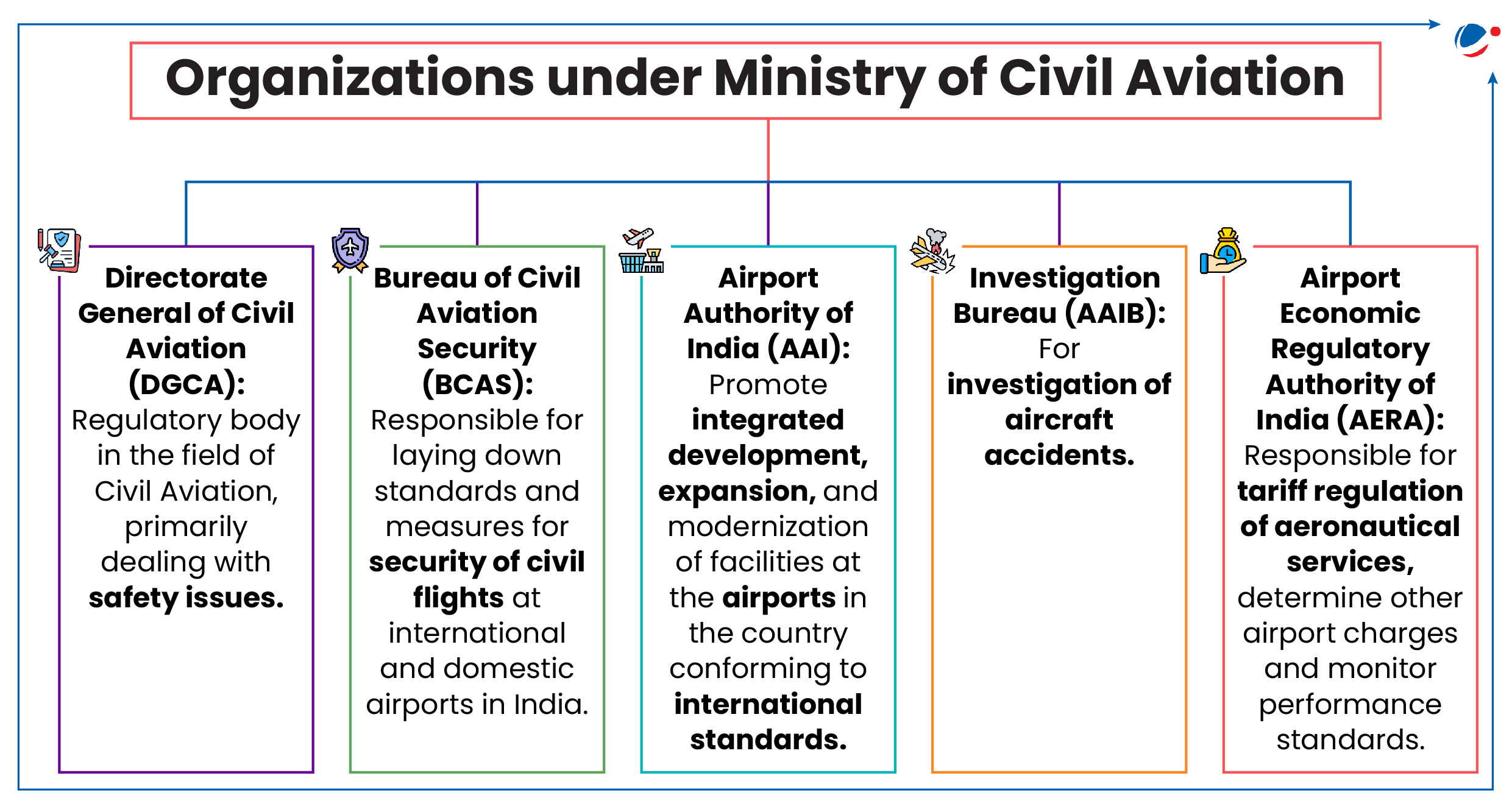Why in the News?
Recently, President granted assent to the Bharatiya Vayuyan Vidheyak (BVV), 2024 aimed at replacing the Aircraft Act, 1934 and modernise India's aviation sector, enhance safety measures, and align with global standards.
Key Features of BVV, 2024
Parameters | Retained from Aircraft Act, 1934 | Addition/ Changes in Bharatiya Vayuyan Vidheyak, 2024 |
Regulatory Structure | The Act sets up 3 authorities:
| Power to issue Radio Telephone Operator (Restricted) Certificate and licencetransferred from Department of Telecommunication to DGCA.
|
Regulation of aircraft-related activities | The Act regulates activities related to aircrafts including manufacturing, use, operation, and trade. | It adds powers to regulate design of aircrafts. |
Power to make Rules | The Act empowers the central government to make Rules on matters including:
| It adds that the central government may make Rules on radio telephone operator certificate and licences under the International Telecommunication Convention. |
Offences and Penalties | Offences punishable with imprisonment up to 2 years, a fine up to ₹1 crore, or both:
| Discretionary Penalties: The Central Government has the discretion to specify civil or criminal penalties for violation of certain Rules. E.g., implementation of international convention, protection of public health etc. |
Adjudication of penalties | Adjudication of penalties: Central government-appointed Adjudicating Officer of the rank of the Deputy Secretary or above. First Appeal: Appellate Officer, who must be of a higher rank than the Adjudicating Officer. | Second Appeal: Second Appellate Officer, must be an officer of a higher rank than the First Appellate Officer. |

Concerns related to BVV 2024
- Lack of independence of DGCA: The central government exercises superintendence over DGCA unlike other regulatory bodies of telecom, insurance and electricity sector.
- Appellate System: Appeals against decisions of bodies like DGCA are limited to the Union Government, potentially affecting their efficacy.
- Arbitration: Unilateral appointment of Arbitrator by Government in cases related to compensation is seen to be violative of the Right to Equality (Article 14).
Aviation Governance in India
- The aviation industry in India is governed by the Ministry of Civil Aviation (MoCA).
- Its primary responsibility is formulation of policy, rules, and regulations related to civil aviation operations in the country or related to international civil aviation operations from the country.

- Key legislations:
- Aircraft Act 1934 (and Aircraft Rules, 1937): Regulates various activities related to civil aviation, and licensing of airports.
- The Airports Economic Regulatory Authority of India (AERA) Act, 2008: Set up an independent authority to regulate tariffs for aeronautical services delivered at airports and monitor the performance standards of airports.
- FDI Policy: 100% FDI is permitted in scheduled Air Transport Service/Domestic Scheduled Passenger Airline (Automatic upto 49% and Government route beyond 49%).
- However, for NRIs 100% FDI is permitted under automatic route.
- 100% FDI in Greenfield and Brownfield airport projects.
Key Initiatives for India's Aviation Sector
- Policies:
- National Civil Aviation Policy, 2016: Aimed at making regional air connectivity affordable and convenient, establish an integrated eco-system promoting growth of civil aviation sector and tourism etc.
- Vision 2040 for the Civil Aviation Industry in India: A strategic roadmap by Invest India outlining the long-term goals and strategies for the development of the civil aviation sector.
- Schemes/ Initiatives:
- RCS-UDAN Scheme: Target to operationalize 1,000 UDAN routes and revive/develop 100 unserved & underserved airports/heliports/water aerodromes by 2024.
- Maintenance, Repair and Operations (MRO): Union Budget 2024-25 incentivises MRO activities in aviation.
- Privatization of Airports: Privatization of 25 airports via PPP under the National Monetization Pipeline.
- Technological interventions: NABH Nirman (for airport capacity augmentation), Digi Yatra (for paperless travel) and AirSewa (for online grievance redressal), GPS Aided GEO Augmented Navigation (GAGAN) (developed by AAI and ISRO for Air Traffic Management).
- International Cooperation:
- Delhi Declaration on Civil Aviation (2024): Adopted at the 2nd Asia Pacific Ministerial Conference on Civil Aviation (APMC), it sets a framework for enhancing regional cooperation in civil aviation.
- Carbon neutrality initiatives: Standardization of Carbon Accounting and Reporting framework of Airports.
- Since 2014, 73 airports like Delhi and Bengaluru have switched to 100% green energy usage.
Conclusion
India's aviation sector is on a transformative path, with significant strides in infrastructure development, regional connectivity, and sustainability efforts. Bharatiya Vayuyan Vidheyak, 2024 can promote growth of the sector by removing ambiguity and confusion in the legal framework





